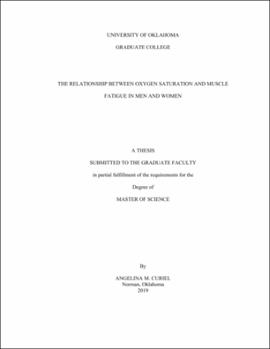| dc.contributor.advisor | Black, Christopher | |
| dc.contributor.author | Curiel, Angelina | |
| dc.date.accessioned | 2019-08-06T15:41:17Z | |
| dc.date.available | 2019-08-06T15:41:17Z | |
| dc.date.issued | 2019-08-01 | |
| dc.identifier.uri | https://hdl.handle.net/11244/321125 | |
| dc.description.abstract | Women have been shown to be more fatigue resistant than men during low-intensity submaximal isometric contractions. It has been suggested higher intramuscular pressures, due to the greater muscle mass and absolute strength of men, may lead to greater reductions in skeletal muscle perfusion during exercise and thus lead to an earlier onset of fatigue.. PURPOSE: The purpose of this study was to investigate the changes in oxygen saturation that occur during a bout of low-intensity isometric exercise in men and women and determine if muscle fatigue occurs at a common point of oxygen desaturation. METHODS: Twenty-four participants (12 male and 12 female) completed four visits consisting of two familiarization visits and two experimental visits. During the familiarization visits, body composition was measured via DEXA and ultrasound, skeletal muscle mitochondrial function was assessed, and participants were familiarized to the isometric exercise protocol. Maximal voluntary contractions (MVC) of the elbow flexors were assessed every visit and for the two experimental visits. An isometric time-to-task failure (TTF) was then performed using a torque equivalent to 20% of MVC using the elbow flexors. During one experimental visit, blood flow occlusion was applied proximal to the elbow flexors during the TTF test and during the other visit blood flow was not occluded—the order these conditions was randomized... MVC was also assessed immediately post exercise and 1-minute post exercise. Oxygen saturation was assessed in the exercising muscles using the deoxyhemoglobin concentration from near-infrared spectroscopy. RESULTS: There were no statistical differences in TTF under normal or ischemic conditions for men and women, however if a participant who was almost a statistical outlier was removed, a sex difference would have been seen. There were no differences in desaturation of hemoglobin between men and women (p > 0.05) showing that men and women desaturate to similar amounts at the same relative time points. There were also no differences in mitochondrial function between men and women (p > 0.05), however both measures of mitochondrial function were moderately correlated, the time constant (r= 0.43) and the slope constant (r = -0.42), to TTF. CONCLUSIONS: In conclusion, we believe that oxygen availability is partly responsible for differences in fatigue between men and women. Further studies should include a larger sample. | en_US |
| dc.language | en_US | en_US |
| dc.subject | Muscle Fatigue | en_US |
| dc.subject | Sex Differences | en_US |
| dc.subject | Near-Infrared Spectroscopy | en_US |
| dc.title | The Relationship between Oxygen Saturation and Muscle Fatigue in Men and Women | en_US |
| dc.contributor.committeeMember | Larson, Rebecca | |
| dc.contributor.committeeMember | Pereira, Hugo | |
| dc.contributor.committeeMember | Kellawan, Jeremy Mikhail | |
| dc.date.manuscript | 2019 | |
| dc.thesis.degree | Master of Science | en_US |
| ou.group | College of Arts and Sciences::Department of Health and Exercise Science | en_US |
